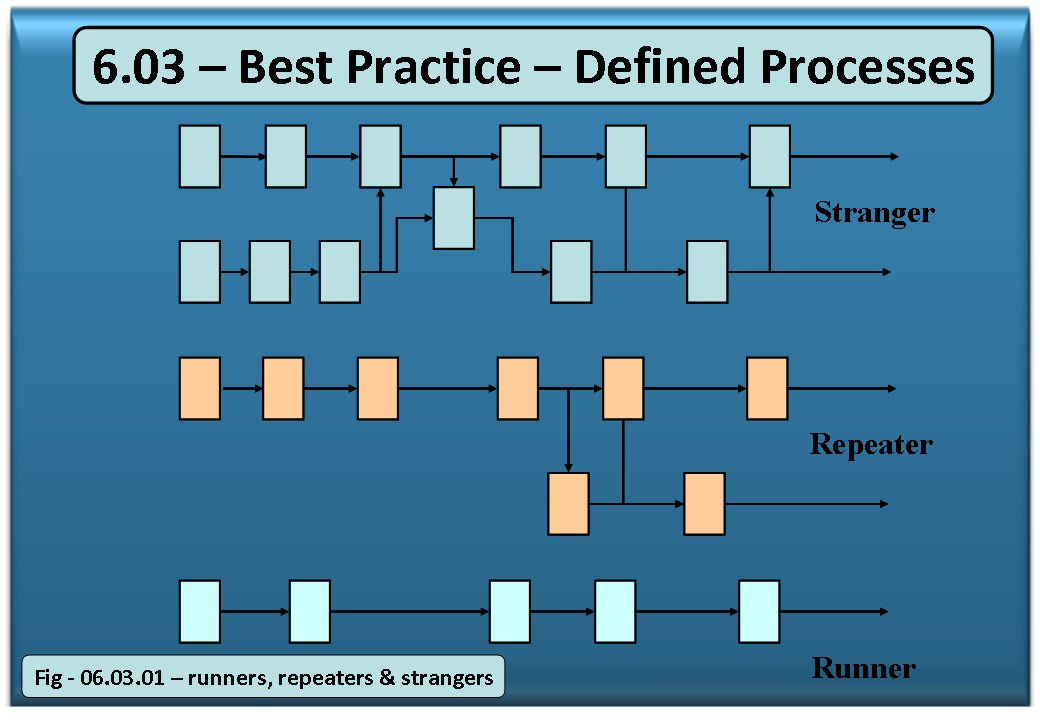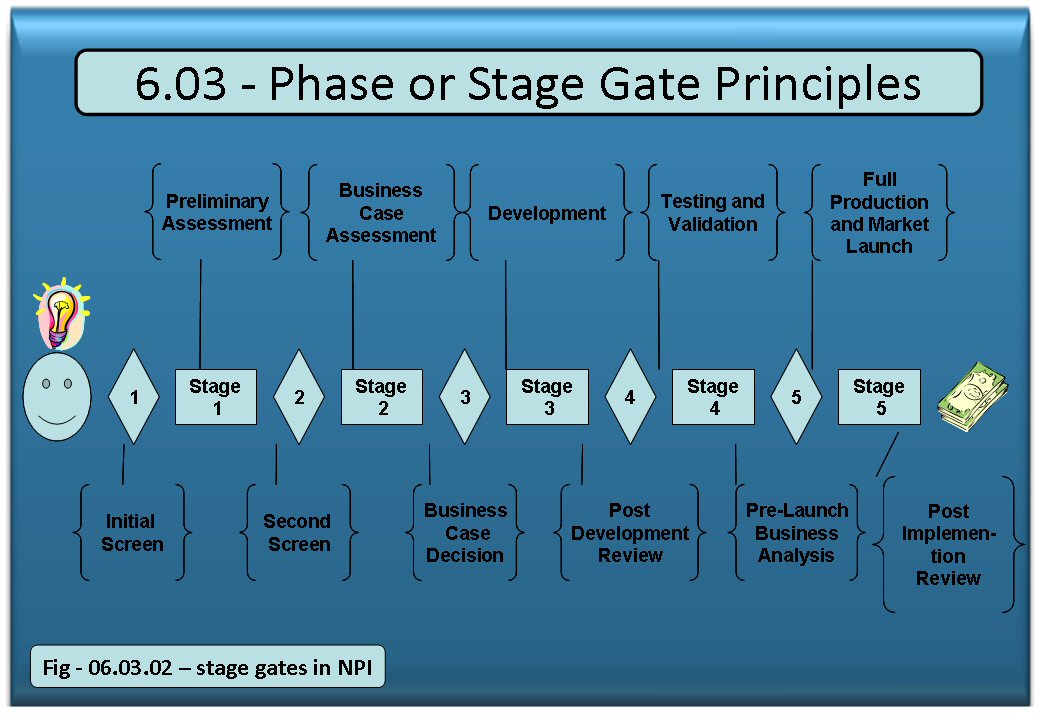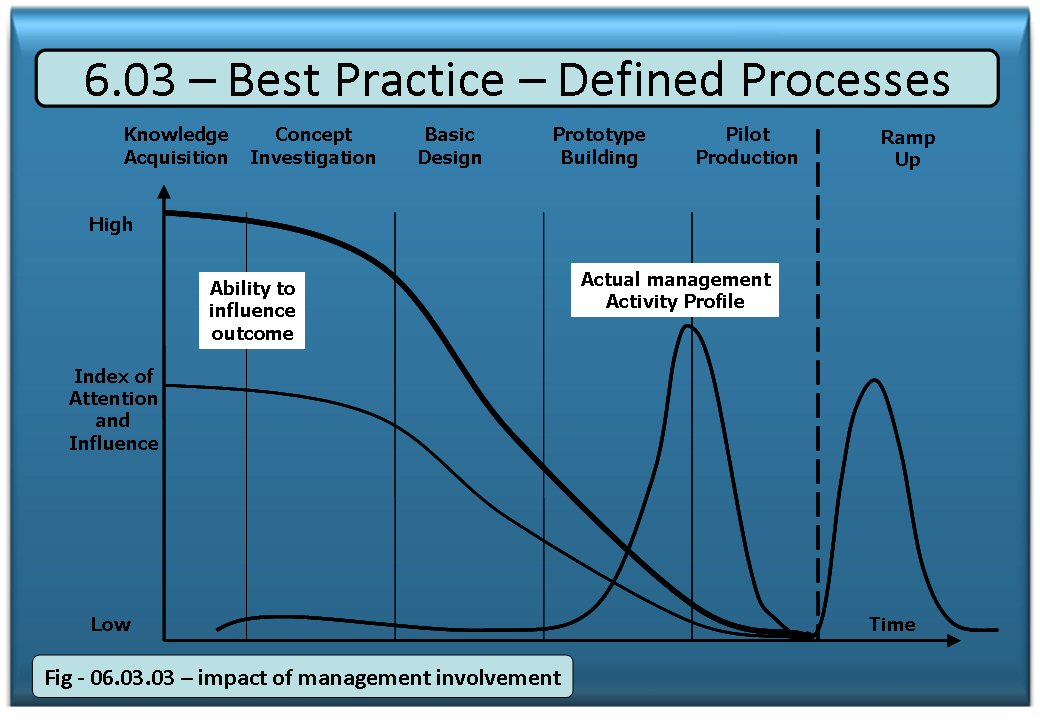6.03 - Best Practice – Defined Processes
Key Elements
To gain control and to reduce risk it is essential to have defined processes that are aligned with the business. In most companies there are a variety of different types of product introduction projects. Every type of project should have its own defined process. One such classification is: runner, repeater, stranger.
Project Type |
Characteristics |
Stranger |
- Radically new product / process / technology to company
- Probably involves research and development
- Long project timescales
- High risk and uncertainty
- High cost – man hours and capital expenditure
- Involves most functional areas
- Project success or failure has a critical impact on the business
- Probably a one off project to step change the business
|
Repeater |
- Uses existing technology in a new way
- Modification to an existing product – little R&D
- Medium term timescales
- Some risk and uncertainty
- Minimal Capital cost
- Team members from limited number of functional disciplines
- Little impact on overall business
- Done something similar before
|
Runner
|
- Very minor change to an existing product / process
- No Research and Development
- Short Duration
- Low risk and uncertainty
- Low cost and no capital expenditure
- Project based in one function
- Normally routine work
- High frequency
|
Process Design

Most companies have one process that is un-documented that supports the most complex project. This results in minor projects being subjected to unnecessary time consuming control and overhead. Organizations should develop their own classification for their projects. Different processes for each of the types should then be developed.
Phase or Stage Gate Systems
World class companies use stage gate systems to control stranger and repeater projects. A typical system with five stages and gates is shown below.

Gates are used to review a project. The make-up of the reviewing committee is determined by the nature of the product and the business and the stage the gate is reviewing. The stages are the major work packages in the project. The documented process should define who is involved, when, what criteria are to be used to evaluate the stages and which tools and techniques should be used in the various stages.
A stage gate system can be used to help gain senior management commitment at the early stages. All too often senior managers do not get involved in a product introduction project until problems surface. This is too late.

The graph shows that managers can have a greater influence at the earlier stages of a project when less cost has been committed.
Products and services are delivered for customers. It is, therefore, common sense to involve customers in the product introduction process. This can be achieved in a variety of ways including:-
- Observing users “use” the product
- Running customer clinics (either one-to-one or group sessions)
- Market surveys of users and buyers
- Including key customers on the project team
Suppliers are experts in their respective fields. Suppliers normally know far more about their products than customers. It may be sensible to let suppliers design non-core competence components. The advantages include:-
- Design of products that are best in terms of cost and functionality
- Scarce engineering resources can be used on more critical components
- Reduced time to market
Concurrent Engineering
Concurrent or simultaneous engineering is the concurrent development of the total product (including packaging, manuals and maintenance plans) and its associated manufacturing system. The benefits of adopting simultaneous engineering concepts include:-
- cutting time to market
- reducing costs and
- Improving customer satisfaction.
Simultaneous engineering is normally deployed by forming multi-functional teams and the use of tools and techniques such as Quality Function Deployment (QFD) and Design for Assembly (DFA). Stage gate systems should be used as an integrated planning and control tool in concurrent engineering. Many companies that deploy concurrent engineering concepts in isolation from these and other wider approaches described in this handbook do not realise the massive benefits that are achievable.
It is important to remember that product introduction measurement is different from day-to-day operations and should be managed as a series of projects. The best practice programme and project management techniques described in other parts of this handbook should be adopted.
Information technology can radically improve product introduction process performance. Product Life Cycle Management, Product Data Management and Workflow Management allow vast quantities of data to be accessible organisation wide and to prioritise activities. Information technology should be used aggressively to optimise the new product introduction process.